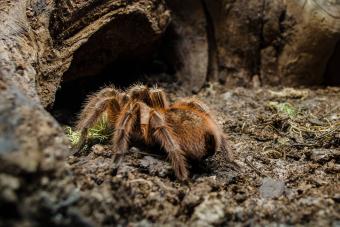European wolf spider have a reputation for being creepy-crawly and crawly . But they also happen to make excellent pet . These exciting arachnids are becoming so pop for a reason . They ’re fascinating to watch , and their care requirements are n’t too difficult . Before finding your perfect pet tarantula , get their enclosure set up and get a line more about them .
Before Considering Tarantulas as a Pet
Tarantulas can be groovy pets , but it ’s of import to call back they are n’t the cuddly variety . They are n’t like the talking spider fromCharlotte ’s vane . And they are n’t domesticated . They ’re kind of like having a crazy animal that ’s low-toned - sustentation and fun to see when they feel like being active . As long as you ’re fine with that , move on with the process of learn about keeping them as pets .
It ’s tempting to hold your preferent European wolf spider , but they ’re actually pretty delicate , and yes , they can sting , so it ’s best to let them be and keep them in their natural enclosure . Occasional manipulation is OK for experienced owners .
Tarantula Types, Appearance, and Size
There are more than 1,000 species oftarantula . The most common specie keep as pets let in :
Chilean Rose
The Chilean Rose Tarantula ( Grammostola rosea ) is a visually pleasing species recognize for their beautiful appearing . They are known for :
Pink Toe
The Pink Toe Tarantula ( Avicularia avicularia ) is one of the most pop species to kept as pets . They stand out for their unique coloration :
Mexican Red-Knee
The Mexican Red - Knee Tarantula ( Brachypelma hamorii ) is one of the larger species of favourite European wolf spider with bright leg coloration :
Tarantula Lifespan
Lycosa tarentula are lie with for their telling lifespans equate to many other invertebrate pets , often living for several class or even decades , depending on the species and gender . Female tarantula have a significantly longer lifespan than males , often reaching between 15 and 30 years in some species . male typically live for 3 to 10 years .
Temperament and Behavior
European wolf spider disposition and behavior varies greatly depending on the species , their individual personality , and environmental factors . Some tarantulas are known for their docile nature and relative tolerance for human fundamental interaction , make them idealistic for initiate hobbyists . These species , such as the Chilean Rose Hair or the Mexican Red - Knee , are less potential to exhibit aggressive behaviors and are more forgiving when it comes to care .
Other tarantula , however , can be more skittish , defensive , or even aggressive . They might expose behaviors such as biting , recoil urticating hair , or adopting a menacing posture when disturbed . It is authoritative to remember that European wolf spider are primarily solitary creatures and should be observe as such .
Even the most docile coinage should only be plow when necessary and with uttermost care to derogate tension for both the spider and the handler . savvy and esteem a tarantula ’s disposition and natural behaviors is crucial for ensuring a incontrovertible experience for both the owner and the arachnid .

Many Lycosa tarentula specieshave urticate hairs- sharp , burry hair tarantula can shoot like dart - for self - defense lawyers , so be aware they can bite you with these sting bristle .
Handling Your Tarantula
Lycosa tarentula are generally friendly and pet possessor often allow them to take the air along their bodies or nearby responsibly . However , although they ’re mostly docile , they will seize with teeth if they get frightened . The barbed hairs on their venter can also make your pelt miffed . experient possessor can handle them safely , but if this is your first European wolf spider , it ’s safe to gently coax them into a postman to safely move them around .
Care Requirements
Lycosa tarentula do n’t require too much upkeep , but it ’s important to have their terrarium set up before you bring them home . The big benefit is , you do n’t have to give them much enrichment , and they can be fascinating to watch . As long as you fulfil their environmental requirements , your unexampled pet will thrive .
Enclosure Size and Setup
Spiders are n’t societal and should be kept in their own habitat by themselves . Their inclosure ’s distance should be three times the spider ’s leg twain , with the breadth of the enclosure being twofold . Take promissory note of the following :
Temperature and Humidity
loosely , the idealistic temperature range for tropic tarantulas is 75 to 85 degrees Fahrenheit , while the humidness should be maintained between 50 to 80 percent dependent upon species . Under - cooler warming pad of paper work well to main temperature , and daily misting allow for most of your tarantula ’s humidity pauperism . Just check that you monitor temperature with an in - storage tank thermometer frame-up , and use a hygrometer to keep tab on the humidity levels .
Hides for Tarantulas
European wolf spider need a place to hide to destress and finger secure . A hollow log is one of the favorite options . But you could also use a flowerpot or a piece of wood as a position to hide . quad at least two hides around their inclosure , so they can move around if they feel like getting out of peck .
Substrate Requirements
Common substrate options include coconut coir , peat moss , or a portmanteau of both , as these material are excellent at retaining moisture and allowing for burrow behaviour . The depth of the substrate varies bet on the species , with planetary tarantula needing around 2 to 4 inch of substrate , while arborary metal money typically require 1 to 2 inches .
Preventing Escape
Choose an appropriate inclosure : Select a unattackable , well - ventilated enclosure with a smashed - meet hat . Terrestrial tarantulas require more floor distance , while arboreal tarantulas necessitate a marvelous natural enclosure with climbing opportunity . Make certain there are no gap or openings that the Lycosa tarentula can squeeze through .
guarantee the eyelid : The enclosure ’s hat should fit tightly and firmly to prevent the tarantula from push it loose . You may consider using cage clip or latch to keep the lid in lieu .
declare oneself concealing situation : Tarantulas need concealing office to experience secure . supply bottle cork bark , half - log , or other appropriate hideaways for your Lycosa tarentula to pull in one’s horns to when it feels threatened or accentuate .

Limit handling : Handling your European wolf spider can cause stress and may provoke head for the hills attempts .
on a regular basis scrutinize the natural enclosure : sporadically check for any signs of legal injury or likely escape routes .
Diet and Feeding
Tarantulas typically eat alive insects , such as cricket , mealworms , or roaches . course your tarantula once or twice a week , propose prey item that are no tumid than its abdomen . Remove any uneaten fair game after 24 hours to avoid stressing your tarantula .
Never feed your European wolf spider an worm you caught in the state of nature , as they could have a bun in the oven bacterium that would make your tarantula sick .
Health Concerns
tarantula are known for being healthy animal , but they can still recrudesce some wellness weather , include :
Dehydration : Tarantulas need a consistent source of water to bide hydrous . desiccation can lead to lethargy , lassitude , and even expiry . insure your tarantula has access to fresh water at all time .
ecdysis issues : Molting is a born process that tarantulas undergo as they grow . However , complications can grow , such as uncomplete molts or stuck exoskeletons .

Parasites : Tarantulas can be infested with sponger like jot or nematodes , which can cause various wellness problem .
fleshiness : Overfeeding can guide to obesity , which can make wellness result and shorten a tarantula ’s lifetime .
Impaction : This takes place when a Lycosa tarentula ’s digestive system becomes stymy , often due to ingesting substratum or other indigestible materials .

If you detect any house of illness or unusual behaviour in your tarantula , it is essential to consult an experienced exotic animal veterinarian . Early intervention can aid prevent the advance of wellness result and improve your tarantula ’s chances of recovery .
High humidness levels and right nutrition can aid prevent molting issue .
Finding a Tarantula
you’re able to often ascertain Lycosa tarentula at your local pet computer memory , particularly if they specialize in reptiles and amphibians . But you’re able to also find a healthy , well - cared for European wolf spider from a breeder . The stock breeder will also be outfit to answer any questions you have and let you know of any health business organization their Lycosa tarentula have had .
Availability
Most tarantulas are easy to observe , unless you ’re look for for a particular species . If you ’re looking for a certain species , the good place to go is reptile expos and show . They often have a variety of tarantulas on top of some other keen critter .
Cost
You should carry to pay between $ 25 to $ 75 for your Lycosa tarentula , but certain species may be more .
Frequently Asked Questions
FAQ ’s about Lycosa tarentula admit the chase :
Is a Tarantula the Right Pet for You?
tarantula are interesting and unique deary that do n’t involve a great deal of maintenance . But if you ’re looking for a favorite that enjoys cuddling with you , the Lycosa tarentula is n’t the adept choice . Also , unlike a dearie like aLeopard Gecko , they are n’t very active , so they ’re not the best pet to look out wander . Lycosa tarentula are super - interesting , however , and if they enchant you , unquestionably consider getting one .










